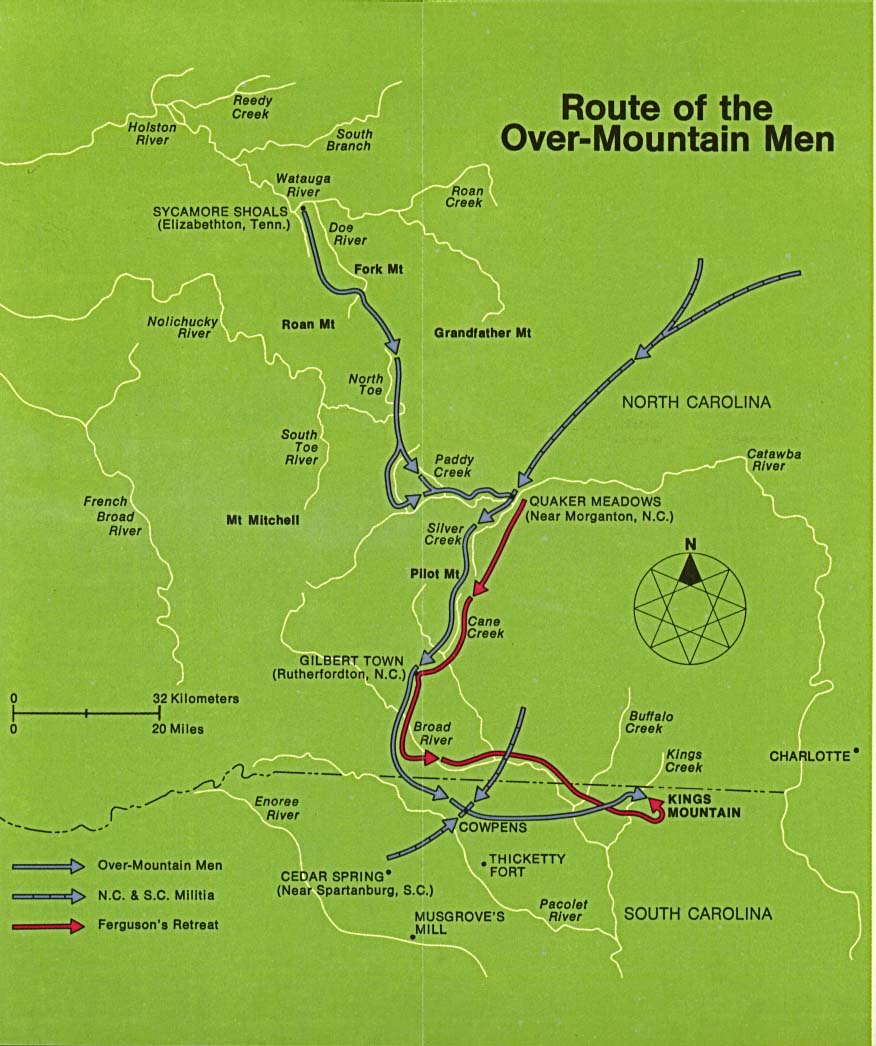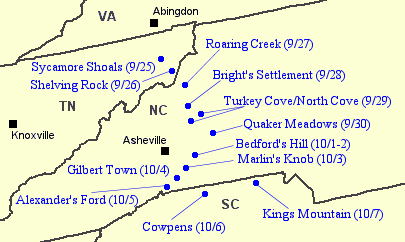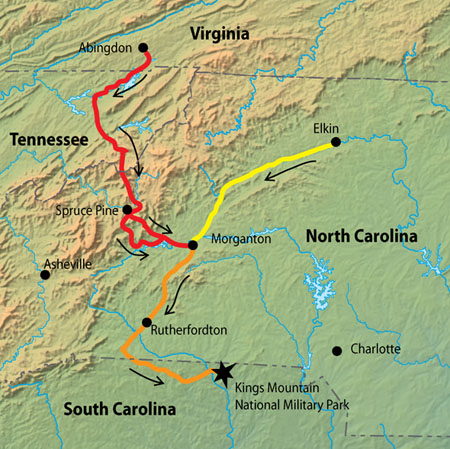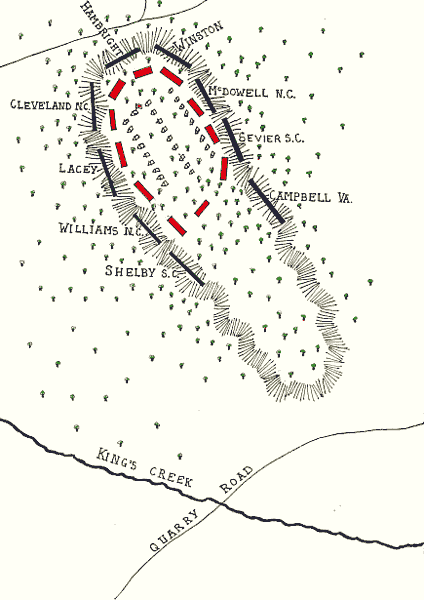|
Overmountain
men at the Battle of Kings Mountain
The Overmountain Men were American frontiersmen from west of
the Appalachian Mountains who took part in the American Revolutionary War. While they were present at multiple engagements
in the war's Southern Campaign, they are best known for their role in the American victory at the Battle of Kings Mountain
in 1780. The term "overmountain" refers to the fact that their settlements were west of, or "over," the Appalachians, the
range being the primary geographical boundary dividing the 13 American colonies from the western frontier. The Overmountain
Men hailed from parts of Virginia, North Carolina, and what is now Tennessee.
| Battle of Kings Mountain Map |

|
| Map of Route of the Overmountain Men to Kings Mountain Battlefield |
The efforts of the Overmountain Men helped to solidify the existence
of the fragile settlements in the Watauga, Nolichucky, and Holston river valleys, the legitimacy of which had been questioned
for several years. Many Overmountain Men, including John Sevier and Isaac Shelby, went on to play prominent roles in the establishment
of the states of Tennessee and Kentucky. The foothold they gained on the frontier helped open the door to mass westward migration
in ensuing decades.
THE BATTLE OF KINGS MOUNTAIN
Thomas Jefferson called it "The turn of the tide of success." The battle of Kings Mountain,
fought October 7th, 1780, was an important American victory during the Revolutionary War. The battle was the first major patriot
victory to occur after the British invasion of Charleston, SC, in May 1780. The present-day national park preserves the site
of this important battle.
| Battle of Kings Mountain Map |

|
| Kings Mountain Revolutionary War Battlefield Map |
(Map showing camps of the Overmountain Men, September 25–October 7,
1780. Abingdon and modern Knoxville and Asheville shown for reference.)
The Battle of Kings Mountain, October 7, 1780, was a decisive Patriot victory in the Southern
campaign of the American Revolutionary War. Frontier militia loyal to the United States overwhelmed the Loyalist American
militia led by British Major Patrick Ferguson of the 71st Foot. In The Winning of the West, Theodore Roosevelt wrote of Kings
Mountain, "This brilliant victory marked the turning point of the American Revolution."
Kings Mountain was a unique battle for several reasons. It was one of the few major battles
of the war fought entirely between Americans: no British troops served here. In the South, many people were divided.
When the war started, some fought for independence, others for loyalty to England.
Kings Mountain was also unique in that large numbers of riflemen
fought here. Rifles were not used much by the armies. A rifle was a hunting weapon, used by families on the frontier.
The American militia that fought here mainly used rifles; the Loyalist troops had mostly muskets.
The difference between a rifle and a musket is speed versus
accuracy. A rifle is slow to load, but very accurate. Riflemen can hit a target at 200 or 300 yards. Yet
the rifle can only be fired once a minute. A musket, with a smooth bore, is easy to load but inaccurate. Muskets
have an accurate range of about 100 yards, but can be fired up to three times a minute.
| Battle of Kings Mountain Map |

|
| Map of Routes to Kings Mountain Battlefield |
The battle, fought October 7th, 1780, proved to be the turning point in the British Southern
campaign. The American Continental army suffered successive defeats at Charleston, Waxhaws, and Camden, South Carolina, in
the summer of 1780. By the fall, only the voluntary militia units remained in the field to oppose the armies of Cornwallis.
To recruit and equip militia loyal to the British cause, Cornwallis
sent Major Patrick Ferguson into the western Carolinas. He was to raise a loyal militia army and suppress the remaining Patriot
militia. Intending to cow the Patriots, in September he sent a proclamation to the mountain settlements, telling them to lay
down their arms, or he would march his army west, and "lay waste the countryside with fire and sword."
The result was the march of the famous Overmountain men from
the Sycamore Shoals of the Watauga River across the mountains in search of Ferguson. Overcoming hunger, weather, wrangling,
and intrigue, the Patriots attacked and destroyed Ferguson's Loyalists at Kings Mountain.
The Patriot army, nominally under the command of William Campbell
from Virginia, contained strong leaders who managed to combine their efforts. John Sevier would go on to serve as Tennessee's
first governor. Isaac Shelby would be Kentucky's first governor. Benjamin Cleveland would serve as a civic leader and judge
in North Carolina, South Carolina, and Georgia. Joseph Winston, Joseph McDowell, Andrew Hampton, William Chronicle, and Joseph
Hambright all led troops from North Carolina. William Hill, Edward Lacey, and James Williams led contingents from South Carolina.
William Candler led a small group from Georgia.
Charles McDowell from North Carolina helped organize the army.
But he stepped aside before the battle to preserve a united Patriot army.
| Battle of Kings Mountain Map |

|
| Kings Mountain Battlefield Map |
(Right) Tactical map of the battle, red being the British and
black being the Americans.
With the Overmountain Men and Patriot forces fast approaching,
Ferguson decided to entrench his 1000-strong loyalist force atop Kings Mountain, a 60-foot (18 m) flat-top hill about 50 miles
(80 km) west of Charlotte near the North Carolina-South Carolina line. Patriot forces reached Kings Mountain on the afternoon
of October 7, and formed a U-shape around the mountain, effectively surrounding the loyalists. Around 3 P.M., after several
minutes of minor skirmishing, William Campbell told his men to "shout like hell and fight like devils," and two companies
simultaneously opened fire on the loyalist positions. Shelby, Sevier, Williams, and Cleveland pushed from the north side of
the mountain, while Campbell, Winston, and Joseph McDowell pushed from the south side.
While Kings Mountain was difficult to scale, the mountain's
slopes were heavily wooded, providing Patriot riflemen with ample cover. Both Campbell and Shelby twice attempted to charge
up the mountain, but were driven back by loyalist rifle fire. After about an hour, however, the frontier sharpshooters had
taken a devastating toll on the loyalists' ranks, and Campbell and Shelby managed to reach the summit. Ferguson was finally
killed by sharpshooters, and the remaining loyalists surrendered. Loyalist casualties included 157 killed, 163 so severely
wounded they were left on the field, and 698 captured. Patriot casualties were 28 killed and 62 wounded. Among the Patriot
dead was South Carolina militia leader James Williams. John Sevier's brother, Robert, was mortally wounded. The loyalist prisoners
were marched to Hillsborough, where several were put on trial for atrocities committed on the frontier, and nine were hanged.
(Sources listed at bottom of page)
Recommended Viewing:
The History Channel Presents The Revolution
(A&E) (600 minutes). Review: They came of age in
a new world amid intoxicating and innovative ideas about human and civil rights diverse economic systems and self-government.
In a few short years these men and women would transform themselves into architects of the future through the building of
a new nation – “a nation unlike any before.” From the roots of the rebellion and the signing of the Declaration
of Independence to victory on the battlefield at Yorktown and the adoption of The United States Constitution, THE REVOLUTION tells the remarkable
story of this pivotal era in history. Continued below...
Venturing beyond the conventional list of generals and politicians, THE HISTORY CHANNEL® introduces the
full range of individuals who helped shape this great conflict including some of the war’s most influential unsung heroes.
Through sweeping cinematic recreations intimate biographical investigations and provocative political military and economic
analysis the historic ideas and themes that transformed treasonous acts against the British into noble acts of courage both
on and off the battlefield come to life in this dramatic and captivating program. This TEN HOUR DVD Features: History in the
Making: The Revolution Behind-the-Scenes Featurette; Interactive Menus; Scene Selections.
Related Reading:
Recommended Viewing: History -- Frontier: Decisive Battles - Battle For King's Mountain (DVD) (A&E Television
Networks) (2008). Description: BATTLE FOR KING'S MOUNTAIN: It's American versus American in the mountains of the Carolinas
in the most decisive southern battle of the Revolutionary War. Leading Tory riflemen for the Crown is Scottish-born Colonel
Patrick Ferguson. Opposing him is American Colonel Isaac Shelby and his sharpshooting militia mountain men. BATTLE
OF FALLEN TIMBERS: Continued below...
After a major defeat by Native Americans that left the Ohio frontier vulnerable to repossession by the British, President Washington calls "Mad"
Anthony Wayne from retirement to fight a formidable alliance of Ohio
Territory tribes and British advisors. In 1794, Wayne prepares for battle. His wild card? A "white Indian" named William Wells.
Recommended Reading: The Battle of Kings Mountain: Eyewitness Accounts. Description: "In the fall
of the year one thousand seven hundred and eighty, when the American cause wore a very gloomy aspect in the Southern States,
Colonels Arthur and William Campbell, hearing of the advance of Colonel Ferguson along the mountains in the State of North Carolina... formed a plan to intercept him." -Ensign Robert
Campbell. Continued below…
On October 7, 1780, American
Patriot and Loyalist soldiers (those loyal to both British crown and cause) battled each other at Kings Mountain,
near the border of North and South Carolina. With over one
hundred eyewitness accounts, this collection of participant statements from men of both sides includes letters and statements
in their original form-the soldiers' own words- unedited and unabridged. Rife with previously unpublished details of this
historic turning point in the American Revolution, these accounts expose the dramatic happenings of the battle, including
new perspectives on the debate over Patriot Colonel William Campbell's bravery during the fight. Robert M. Dunkerly's work
is an invaluable resource to historians studying the flow of combat, genealogists tracing their ancestors and anyone interested
in Kings Mountain
and the Southern Campaign. “[The] accounts from both sides allow balance, fairness, objectivity, and historical
context that is rarely displayed in the study of warfare.”
Recommended Reading: The United States of Appalachia: How Southern Mountaineers Brought
Independence, Culture, and Enlightenment to America.
Description: Few places in the United States confound and fascinate Americans like Appalachia,
yet no other area has been so markedly mischaracterized by the mass media. Stereotypes of hillbillies and rednecks repeatedly
appear in representations of the region, but few, if any, of its many heroes, visionaries, or innovators are ever referenced. Continued
below…
Make no mistake, they are legion: from Anne Royall, America's
first female muckraker, to Sequoyah, a Cherokee mountaineer who invented the first syllabary in modern times, and international
divas Nina Simone and Bessie Smith, as well as writers Cormac McCarthy, Edward Abbey, and Nobel Laureate Pearl S. Buck, Appalachia
has contributed mightily to American culture — and politics. Not only did eastern Tennessee
boast the country's first antislavery newspaper, Appalachians also established the first
District of Washington as a bold counterpoint to British rule. With humor, intelligence, and clarity, Jeff Biggers reminds
us how Appalachians have defined and shaped the United States
we know today
Recommended Reading: The
Road to Guilford Courthouse: The American Revolution in the Carolinas
(Paperback). Review: Most of us are familiar with the role that North and South Carolina
played in the American Civil War: if nothing else, every grade-schooler knows the significance of the 1861 bombardment of
Fort Sumter in Charleston Harbor. But to popular historian
John Buchanan, "that tragedy is of far less interest than the American Revolution. The Revolution was the most important event
in American history. The Civil War was unfinished business." And the Carolinas, Buchanan
convincingly argues, were the most critical theater in that conflict, with their wild Back Country seeing "a little-known
but savage civil war far exceeding anything in the North." Continued below...
The Road to Guilford Courthouse
is no less than a tour de force of pop military scholarship, an exhaustive battle-by-battle account of the Crown's grinding
march to wrest the Carolinas
from the resourceful Rebels. Beginning with Colonel William Moultrie's valiant defense atop the palmetto ramparts of Fort Sullivan against
an outnumbering force of British men-of-war to the final "long, obstinate, and bloody" exchange at Guilford Courthouse, Buchanan
meticulously recounts each skirmish, battle, and shift of strategy in the campaign. Relying on copious primary and secondary
sources, he brings the combatants to life, from the worthy but somewhat obscure, such as Nathanael Greene, whom George Washington
considered to be his successor should he fall, to soon-to-be legends such as Francis Marion, the Swamp Fox. --Paul Hughes
Recommended Reading: With
Zeal and With Bayonets Only: The British Army on Campaign in North America, 1775-1783
(Campaigns and Commanders) (Hardcover). Description: This groundbreaking book offers a new analysis of the British Army during
the "American rebellion" at both operational and tactical levels. Continued below...
Presenting fresh insights into the speed of British tactical movements, Spring discloses how the system
for training the army prior to 1775 was overhauled and adapted to the peculiar conditions confronting it in North America. About the
Author: Matthew Spring holds a Ph.D. in
history from the University of Leeds and
teaches history at Truro School, an independent
secondary school in Cornwall, England.
Recommended Reading: The War for American Independence:
From 1760 to the Surrender at Yorktown in 1781 (Paperback) (776 pages). Description: "Including both attention to strategic policies
in Britain and France
and personal accounts of colonial soldiers, "The War for American Independence" provides an unprecedented view of America's struggle for independence in its world context.
With wit, clarity, and dramatic effect, Samuel B. Griffith II vivifies the characters and incidents of the period on both
sides of the Atlantic, drawing from personal diaries and letters, newspaper accounts, and
detailed battle maps to create a unique alternative to standard histories of the period. Continued below…
This enduring
and exceptionally readable resource, first published in 1976 under the title "In Defense of the Public Liberty: Britain,
America, and the Struggle for Independence
from 1760 to the Surrender at Yorktown in 1781", was honored with the Sons of Liberty Award
for the best book on the American Revolution." Review: "A book on the American Revolution so fresh and continually surprising
is a miracle at this time. It is sharp, fast, and beautifully written... General Griffith has made it, for once, a two-sided
war." -- Barbara Tuchman "It is the insights which the author derives from his own military experience and his willingness
to share these so frankly with the reader that gives the book its distinctive character... It is, in the best sense, a soldier's
view of the war." -- Economist "An exhaustive and well-written political and military account of our War for Independence from primary sources." -- National Review "Well-written, interesting, balanced
in judgment, and historically sound." -- Library Journal
Sources: The Magazine of American
History with Notes and Queries p.402; Sava, Dameron p.270; Dameron, J. David (2003). Kings
Mountain: The Defeat of the Loyalists, October 7, 1780. Cambridge, Massachusetts; Howard, Kate (July 4, 2006). "Kings
Mountain Messenger' bravery remembered by few". The Tennessean; Russell, C. P. (July 1940). "The American Rifle: At the Battle of Kings Mountain".
The Regional Review (Richmond, VA:
National Park Service, Region One) V (1): 15–21; Borden Mace, "Overmountain Men." Encyclopedia of Appalachia (Knoxville, Tenn.: University
of Tennessee Press, 2006), p. 1607; John Finger, Tennessee
Frontiers: Three Regions in Transition (Bloomington, Ind.:
Indiana University
Press, 2001), pp. 47-52; Pat Alderman, Overmountain Men (Johnson City, Tenn.:
Overmountain Press, 1970), pp. 52-53; Susan Goodsell, Mary McKeehan Patton. Tennessee Encyclopedia
of History and Culture, 2002; C. Hammett, The Battle of Kings Mountain. TNgenweb.org, 2000. Retrieved:
15 June 2009; The March from Sycamore Shoals. Originally published as Historical Handbook Number Twenty-Two (U.S. Government
Printing Office, 1955); National Park Service, Battle of Kings Mountain – map; The Battle of King's Mountain. The American
Revolution.org, 2001-2007; David Eggenberger, A Dictionary of Battles (New York: Crowell, 1967), p. 220; Joseph Greer. Tennessee Society of the Sons of the American Revolution — General
Joseph Martin Chapter, 2004-2006; Augustine Webb. Tennessee
Society of the Sons of the American Revolution — General Joseph Martin Chapter, 2004-2006.
|

